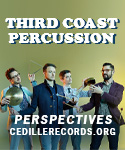This is one of two companion albums for Yo-Yo Ma’s globe-trotting Silk Road Project, which has raced around the world both conceptually and literally, with live performances in Asia, Europe, and North America. (Another complementary accessory, if you’re interested in further exploration, is Smithsonian Folkways’ exemplary two-disc set of field and studio recordings of traditional and non-Western classical music, which has much more ethnological bent.) But taken as a stand-alone title, Silk Road Journeys is an invigorating, eye-opening ride. To be sure, some pieces fare better than others, but as with any unforgettable trip, you tend to forget the occasional bumps you hit along unknown roads. Our guides are a generally stellar selection of master artists, including the luminary pipa player Wu Man and kemencheh and setar player Kayhan Kalhor. These two musicians in particular can go head-to-head in virtuosity with Yo-Yo Ma any day. Complemented by cleanly articulated sound, Sony Classical has produced a real keeper in its Yo-Yo Ma catalog, but the cellist makes his collaborators the true focus of this album.
The disc neatly divides itself into two segments: the first half nods to east and central Asia, and the second focuses on the western part of the continent. It opens with a powerhouse performance by the young Mongolian singer Ganbaatar Khongorzul, singing a traditional long song that is simply breathtaking for her exquisite control and remarkable power. Following similar lines, Mongolian composer Byambasuren Sharav uses another long song, The Legend of Herlen, as the jumping-off point for his own work. Though the piece possesses a mystical, mesmerizing combination of the horsehead fiddle (called the morin khuur–and played by Ma!), delicate piano, and percussion as well as Khongorzul’s amazing voice, Sharav falls into the sway of clichéd thundering drum rolls and brass to express excitement.
Wu Tong and Li Cang Sang present arrangements of two traditional Chinese compositions (Blue Little flower and Mido Mountain). Set off by Ma, plus bass (played by Edgar Meyer), percussion, and Indian tabla, three staple instruments of Chinese music are present: pipa (a plucked lute), the bowed erhu, and the mouth organ sheng played by the master artist Wu Tong. Wu Tong’s fiery, growling vocals on the first song go uncredited, but it’s worth noting that he is renowned in China as a rock star as well as a traditional artist.
Zhao Jiping, a composer known for film scores such as Farewell My Concubine and Raise the Red Lantern, offers Moon Over Guan Mountains, a work that places the Western cello in conversation with pipa and sheng, and–puzzlingly–tabla. It’s effective enough as an evocative, quasi-programmatic piece, but it wears out its welcome. (Shane Shanahan’s tabla solo also is enough to demonstrate that he has far to go before he is a truly first-rate player. The master tabliya lets the drums sing; Shanahan simply thuds along.) The global-village focus of this project is clearly at the center of Michio Mamiya’s work. Perhaps surprisingly, Mamiya doesn’t reference his native Japan; instead, Five Finnish Folksongs concentrates on the Saami (Lapp) traditions of Finland. We hear the third and the fifth from that series, “Miero vuoti uutta kuuta” and “Joiku”. Titles notwithstanding, there’s an almost French-sounding delicacy and whimsy that suffuses these pieces for cello and piano.
Persia (along with its neighbor, Azerbaijan) dominates the second half of the disc. Kayhan Kalhor, here performing on the lute called the setar, is joined by Siamak Jahangiri on the ney bamboo flute and Siamak Aghaei playing santur, a hammered dulcimer. In Avaz-e Dashti, they offer sparkling improvisations on motifs from the Persian classical tradition. Franghiz Ali-Zadeh’s Habil-Sayagy draws equally from traditional Azeri music and John Cage. His composition, scored for cello and piano, is a thought-provoking mixture of the two.
From the rich wellspring of Persian classical inspiration comes the disc’s longest selection, Kalhor’s Blue as the Turquoise Night of Neyshabur, which employs an array of Western stringed instruments as well as Persian instruments: the kemencheh spiked fiddle, the ney, and santur, with the Indian tabla thrown in for good measure. (Persian and North Indian classical music historically share many links, so this inclusion isn’t jarring.) As this title might well suggest, Kalhor’s music is evocative and richly colored, and his compositions tend toward the lovely and gentle. This piece is no exception: with its swooning, lyrical melodies and thundering percussion–like horses racing across Iran’s Khorasan plains–it’s easy to imagine Blue as the film score for a sweeping Persian epic of love and war yet to be written. The disc closes with a lilting, very enjoyable multicultural arrangement of an Italian Renaissance tune, Filippo Azzaiolo’s song “Chi passa per’sta strada” (which was played as an encore at two of the three Carnegie Hall live performances the ensemble gave earlier this year). The “bonus” track is a minute-and-a-half-long selection from Tan Dun’s score for Crouching Tiger, Hidden Dragon, here arranged for some of the Silk Road players. It’s charming, but not long enough to have any real impact.
































